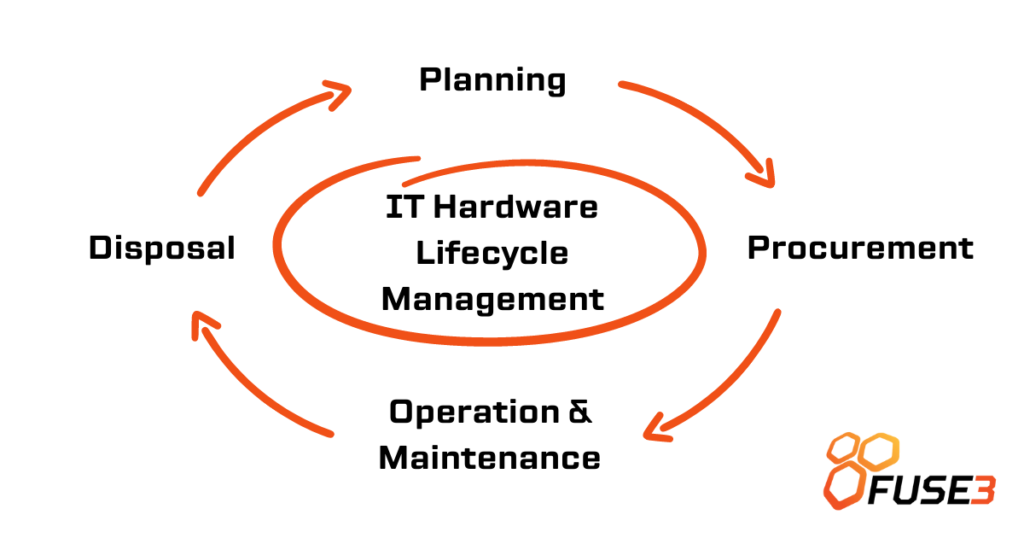
An IT asset’s lifecycle encompasses everything that occurs from initial determination of need to eventually disposing of the asset after it is no longer useful. Assets such as PCs, Laptops, Servers, Printers, Scanners, etc. are considered IT hardware. IT Asset Management (ITAM) allows businesses to optimize the useful lives of their assets and get the most out of a limited lifespan.
The Purpose of IT Asset Management
A well-designed asset management process delivers considerable benefits through cost management, increased agility, and reduced risk. ITAM is a framework and set of processes for strategically tracking and managing financial and physical aspects of IT assets through their lifecycle.
Hardware Lifecycle Stages
Hardware Assets go through 4 main stages during their lifecycle: planning, procurement, operation, and maintenance, and disposal. Each stage plays an important role in ensuring that the asset is utilized to its fullest capacity.
Planning for and then purchasing hardware allows businesses to proactively manage lifecycles, stay within annual budgets, prevent hasty overpriced purchases, and eliminate downtime while assets are replaced.
Regularly monitoring the function of the equipment during operation can prevent performance issues. Using a preventative maintenance strategy will reduce downtown, minimize emergency repair costs, increase equipment uptime, and prolong asset life expectancy.
At the end of an asset’s lifecycle, the hardware can be sold, re-purposed, thrown away, or recycled. While a planned replacement can begin the lifecycle again without causing downtime.
Developing an Effective IT Asset Lifecycle Management Process
It is important to base your process on three main foundations in order to create an effective IT asset lifecycle management process. At a high level, utilizing ITAM allows a business to proactively budget for new or replacement hardware, schedule preventative maintenance, and ensure that downtime caused by IT hardware is minimized.
Management Strategy
There needs to be a shared vision among all organization levels, starting with the executive level and IT team. Discuss business requirements in order to establish a consensus on business objectives and implementation. Strategically review and discuss the following:
- How your company does business
- How your company reaches decisions
- What processes your company follows
- What IT hardware does your company use
- How your company communicates information
Developing and implementing a strategic IT asset management plan will allow your organization to provide services effectively. When you examine which assets your organization currently owns, the importance of each asset and what the future costs and values may be, you will be able to achieve the highest amount of worth for your assets.
Your asset management plan can allow you to understand how much each of your assets are being used. From there, you can determine the value of an asset over its entire lifecycle and plan for future purchases accordingly.
Organizational Design
You need the right people and processes working together at the right time and towards a common goal. For a successful process, each role and responsibility needs to be clearly defined. Qualified resources must also be readily available to meet management objectives.
Long-Term Planning
Avoid the reactive approach of short-term planning. When you have a long-term plan in place, you will be able to more effectively forecast where and when asset investments should occur. Determine the current condition and capacity of the company’s infrastructure, and what the forecasted future capacity will be. This will allow you to decide how best to invest limited capital. Finally, it is important to understand the risk and cost associated with implementing or deferring system improvements.
Life Expectancy of IT Hardware
The average life expectancy of IT hardware is three to five years. PCs and Servers tend to last closer to 5 years, while mobile devices such as laptops have a shorter lifespan due to the wear and tear of travel. Although hardware does often run for much longer than 5 years, if you are trying to keep things running at top efficiency, you should question anything older than that.
In addition to preventing failure and downtime by upgrading equipment, advances in software need to be considered. Oftentimes, software will mandate when hardware must be changed as the platform may no longer support the requirements of the software. This can greatly reduce the usability of your hardware if the software it requires is no longer compatible.
FUSE3 Can Help
Forecasting, purchasing, tracking, and maintaining hardware probably aren’t “top on your list,” but they do matter when it comes to organizational efficiency. We know how crucial it is to manage your IT hardware lifecycle. That’s where we come in. FUSE3 provisions, secures and inventories your IT hardware, ensures all drivers and software are up to date, manages your licenses, integrates new with existing equipment, and more. Contact us for a free assessment.
